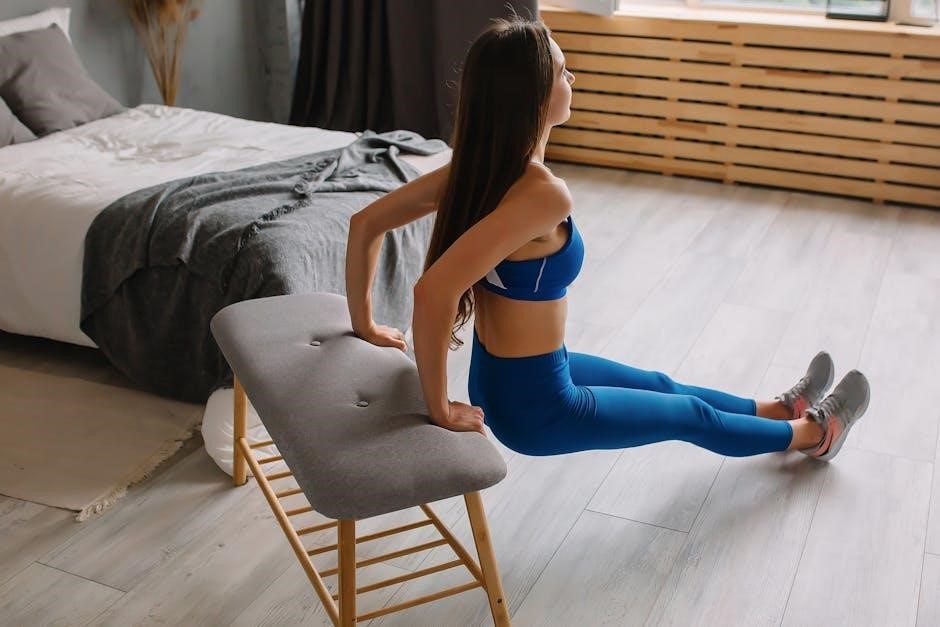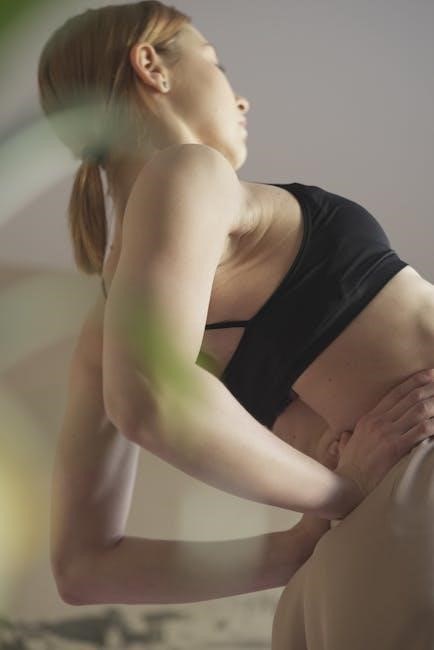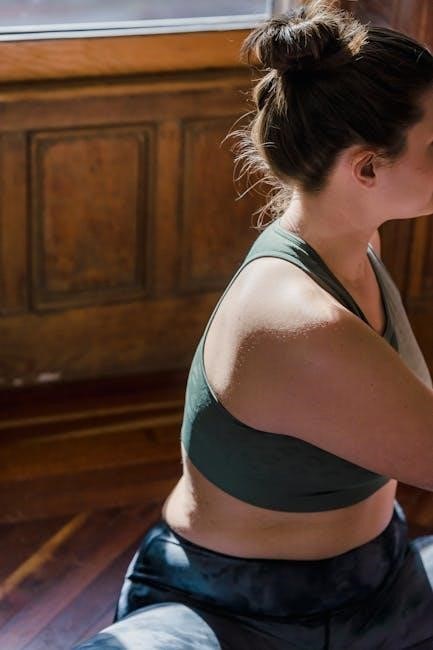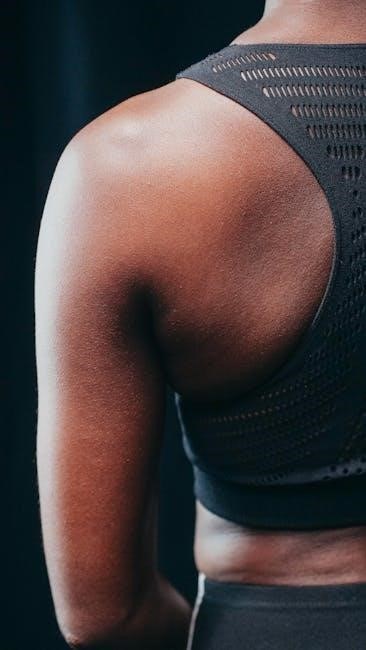A reverse total shoulder replacement is a surgical procedure designed to address severe shoulder conditions like rotator cuff arthropathy or fractures, restoring mobility and reducing pain. It involves flipping the shoulder joint’s anatomy, enabling the deltoid muscle to compensate for the damaged rotator cuff. This innovative approach helps patients regain functional movement and strength, with post-operative exercises playing a critical role in achieving optimal recovery and long-term outcomes.
Overview of the Procedure and Its Benefits
Reverse total shoulder replacement is a surgical procedure that addresses severe shoulder conditions like rotator cuff arthropathy, fractures, or degenerative joint disease. The procedure involves swapping the shoulder joint’s ball and socket, allowing the deltoid muscle to compensate for the damaged rotator cuff. This approach improves mobility, reduces pain, and restores functional strength. Patients often regain the ability to perform daily activities and enjoy enhanced quality of life; The surgery is particularly beneficial for those with limited arm movement or chronic discomfort, offering a reliable solution where traditional shoulder replacement may not be effective. Proper rehabilitation and exercises are crucial for maximizing outcomes.

Importance of Post-Operative Exercises
Post-operative exercises are vital for recovery after reverse total shoulder replacement, enhancing shoulder mobility, strength, and flexibility while minimizing complications. They ensure proper healing and restore function effectively.
How Exercises Contribute to Recovery and Shoulder Mobility
Exercises play a crucial role in recovery after reverse total shoulder replacement, improving mobility, strength, and flexibility. They help restore joint function, promote healing, and prevent stiffness. Pendulum exercises enhance range of motion, while theraband exercises strengthen muscles. Wall slides improve elevation and abduction, reducing the risk of complications. Consistent exercise routines also minimize pain and inflammation, fostering a faster return to daily activities. By targeting the deltoid and surrounding muscles, these exercises ensure proper joint mechanics and long-term mobility. Adhering to a structured exercise plan is essential for achieving optimal outcomes and maintaining shoulder health post-surgery.

Phases of Rehabilitation
Rehabilitation after reverse shoulder replacement is divided into three phases: early (0-6 weeks), intermediate (6-12 weeks), and advanced (3-6 months), each focusing on healing, strength, and mobility.
Early Post-Surgery Phase (0-6 Weeks)
The initial phase focuses on healing and preventing complications. Patients wear a sling to protect the shoulder and avoid heavy lifting or active movements. Gentle exercises like pendulum swings and passive range-of-motion activities are introduced to maintain mobility without stressing the repair. Pain management is crucial, often guided by prescribed medication. Patients are advised to avoid driving and to follow a structured rehabilitation plan tailored by their surgeon or physical therapist. This period lays the foundation for successful recovery by balancing rest and controlled movement.
Intermediate Phase (6-12 Weeks)
During this phase, patients gradually transition from passive to active exercises, focusing on strengthening the shoulder and improving flexibility. Theraband exercises, such as rowing and external rotations, are introduced to build muscle endurance. Wall slide exercises continue to enhance elevation and abduction. Patients are encouraged to perform these exercises consistently, avoiding movements that cause pain. Gentle stretching and controlled movements are emphasized to prevent overexertion. Supervision by a physical therapist ensures proper form and progression. This phase is critical for rebuilding strength and preparing the shoulder for more advanced activities in the next stage of recovery.
Advanced Phase (3-6 Months)
In the advanced phase, patients focus on strengthening and improving functional mobility. Resistance exercises with bands or light weights are introduced to enhance deltoid and surrounding muscle strength. Dynamic movements, such as controlled arm swings and elevated reaching, are incorporated to restore natural shoulder mechanics. Patients are encouraged to engage in low-impact aerobic activities, like swimming, to promote joint health without overloading the shoulder. It’s crucial to avoid heavy lifting or repetitive overhead movements to protect the implant. Supervised physical therapy ensures proper progression and prevents complications, helping patients achieve long-term functionality and independence in daily activities.

Specific Exercises for Recovery
Key exercises include pendulum movements for mobility, Theraband rows for strength, and wall slides to improve elevation and abduction. These targeted routines enhance shoulder function and flexibility safely.
Pendulum Exercises for Shoulder Mobility
Pendulum exercises are essential post-surgery to restore shoulder mobility without stressing the joint. Patients bend at the waist, letting the affected arm hang freely like a pendulum. Gentle swings in small circles or side-to-side motions are performed for 5-10 minutes, 2-3 times daily. These exercises promote blood flow and prevent stiffness. Surgeons typically recommend starting them once cleared, usually within the first few weeks. Proper form is crucial to avoid complications, making guidance from a physical therapist beneficial. Consistency ensures gradual improvement in range of motion, supporting overall recovery and functional ability.
Theraband Exercises for Strength and Flexibility
Theraband exercises are a key component of recovery, focusing on rebuilding strength and improving flexibility. Using a resistance band, patients perform controlled movements like rows, internal rotations, and external rotations. These exercises are typically introduced once pain allows, often around 6-8 weeks post-surgery. Patients are advised to complete 3 sets of 10-15 repetitions, twice daily. Proper form is essential to avoid injury; Theraband exercises help restore muscle balance and enhance functional abilities. They are tailored to individual progress and are a vital part of achieving long-term shoulder health and mobility. Consistency and adherence to the prescribed regimen ensure optimal outcomes.
Wall Slide Exercises for Elevation and Abduction
Wall slide exercises are designed to improve shoulder elevation and abduction, essential for regaining functional movement. Patients stand close to a wall, placing their unaffected side against it for stability. The operated arm slides up the wall, using the good arm for assistance if needed, to maximize elevation. This exercise is performed in a controlled manner to avoid discomfort. It is typically introduced in the early stages of recovery to promote gentle stretching and mobility. Consistency in performing wall slides helps restore range of motion and strengthens the shoulder muscles, making daily activities easier. Proper technique is crucial to avoid strain and ensure progress.

Precautions and Safety Guidelines
Avoid heavy lifting, driving for 2-4 weeks, and unapproved exercises. Follow prescribed routines, manage pain with medication, and seek medical advice for complications immediately.
Avoiding Complications During Recovery

To prevent complications after reverse shoulder replacement, patients must adhere to post-operative guidelines. Avoid heavy lifting, bending, or activities that strain the shoulder. Driving should be avoided for 2-4 weeks. It’s crucial to follow the prescribed exercise regimen carefully, as overexertion can lead to implant dislocation or soft tissue damage. Managing pain with medication before exercises can help reduce discomfort and prevent overstrain. Additionally, attending all follow-up appointments ensures proper healing. Immediate medical attention is necessary if signs of infection, severe pain, or mobility loss occur. Compliance with these precautions enhances recovery outcomes and minimizes risks associated with the procedure.

Role of the Deltoid in Reverse Shoulder Replacement
The deltoid muscle plays a crucial role in reverse shoulder replacement, compensating for the damaged rotator cuff by enabling elevation and abduction of the arm, restoring functional movement.
Understanding the Deltoid’s Function Post-Surgery
After reverse shoulder replacement, the deltoid muscle assumes the role of the rotator cuff, facilitating movements like arm elevation and abduction. Proper rehabilitation exercises, such as those detailed in downloadable PDF guides, are essential to strengthen the deltoid and ensure optimal recovery. Patients are advised to follow structured exercise routines, including pendulum and Theraband exercises, to enhance shoulder mobility and strength. Adhering to post-operative guidelines and avoiding overexertion are crucial to prevent complications and promote a successful recovery. The deltoid’s function is vital for restoring normal shoulder mechanics and enabling patients to perform daily activities with ease and confidence.

Downloadable PDF Guides
Comprehensive exercise plans for reverse total shoulder replacement are available in downloadable PDF guides, offering detailed routines to aid recovery and improve shoulder mobility effectively.
Access to Comprehensive Exercise Plans
Downloadable PDF guides provide detailed, structured exercise plans tailored for reverse total shoulder replacement recovery. These resources include step-by-step instructions for pendulum, Theraband, and wall slide exercises, ensuring proper progression through rehabilitation phases. The guides cover early post-surgery mobility, intermediate strength-building, and advanced functional movements. They emphasize the importance of consistent practice and offer tips for managing pain during exercises. Patients can access these guides to follow a clear, personalized recovery program, aiding in restoring shoulder function and mobility effectively. The PDFs serve as invaluable tools for patients and therapists, promoting adherence to prescribed routines and enhancing overall recovery outcomes.

Leave a Reply
You must be logged in to post a comment.